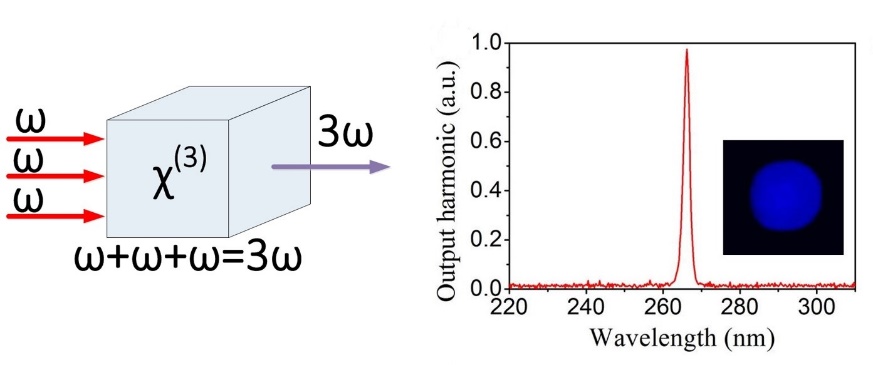Ultraviolet (UV) laser is usually produced from a commercially available infrared laser through a cascaded (two-step) second-order nonlinear process which occurs only in noncentrosymmetric crystals. Actually, direct one-step of third-order frequency conversion can be the other simplified method to produce UV lasers. It can occur both in noncentrosymmetric and centrosymmetric ones. Because of small third-order nonlinear susceptibilities and low UV transmittance in most of materials, it was difficult to obtain direct third-harmonic generation (THG) in UV region. In a study published in Optics Letters, the research group led by Prof. YE Ning at Fujian Institute of Research on the Structure of Matter (FJIRSM) of Chinese Academy of Sciences reported efficient direct THG at 266 nm in centrosymmetric crystal. To obtain strong direct THG, it was proposed to elect a centrosymmetric crystal with delocalized π bond as the nonlinear media during frequency conversion process. (B3O6)3- group has the largest microscopic susceptibility for UV frequency conversion among all anionic groups. Therefore, α-BaB2O4 which is the BaB2O4 crystal form at high temperature (not the β- BaB2O4) was selected in our experiment. An unprecedented third-harmonic energy 37.6 μJ (average power~37.6 mW) at 266 nm generated in α- BaB2O4 crystal pumped by a femtosecond laser. And the conversion efficiency of 2.5% was increased more than hundredfold compared with that of previous reported. The result indicates the potential of direct THG in practical applications and the feasibility of direct THG in UV region through centrosymmetric crystals. Furthermore, the shortest harmonic matching-wavelength calculated was 215 nm in α- BaB2O4 which was very close to deep-UV region. It indicates the possibility of direct THG in deep-UV region through centrosymmetric crystals, and also demonstrates a new development direction of nonlinear crystals in UV and deep-UV region. 
Figure: Mechanism of direct THG and spectrum at 266 nm. (Image by Prof. YE’s Group) Contact: Prof. YE Ning Fujian Institute of Research on the Structure of Matter Chinese Academy of Sciences Email: nye@fjirsm.ac.cn |

